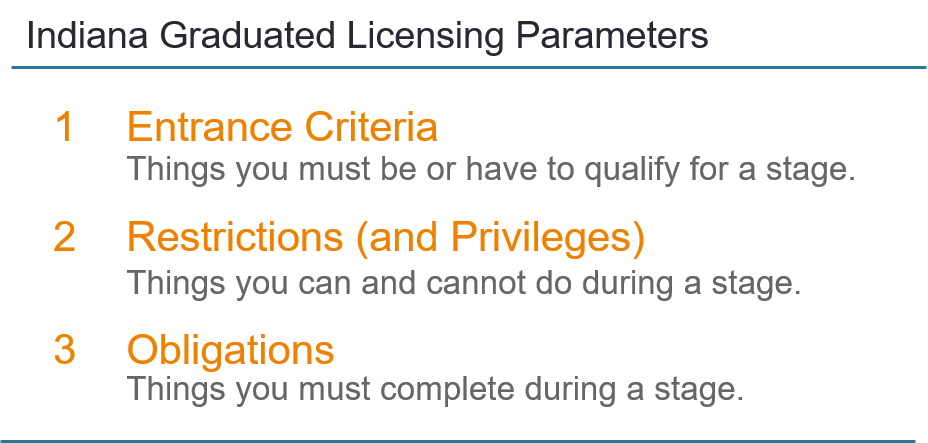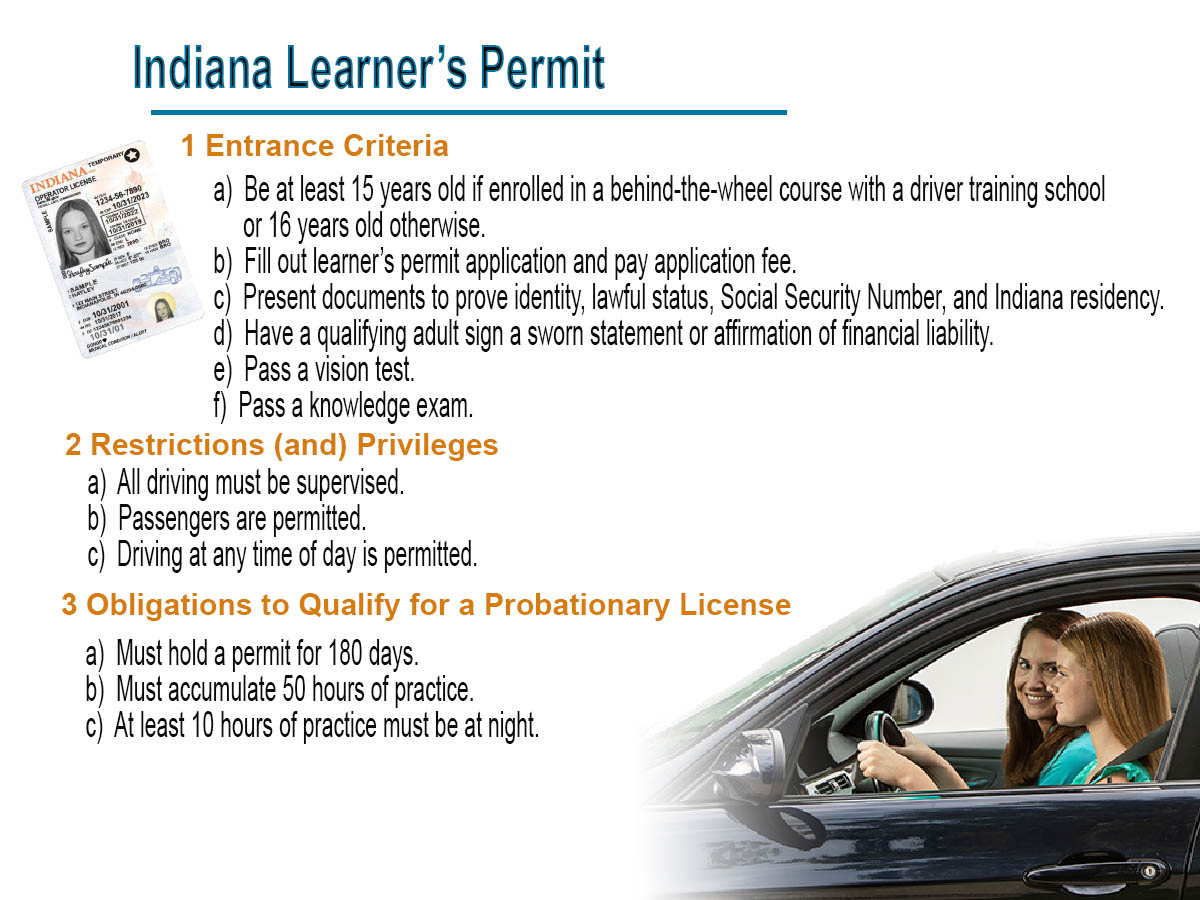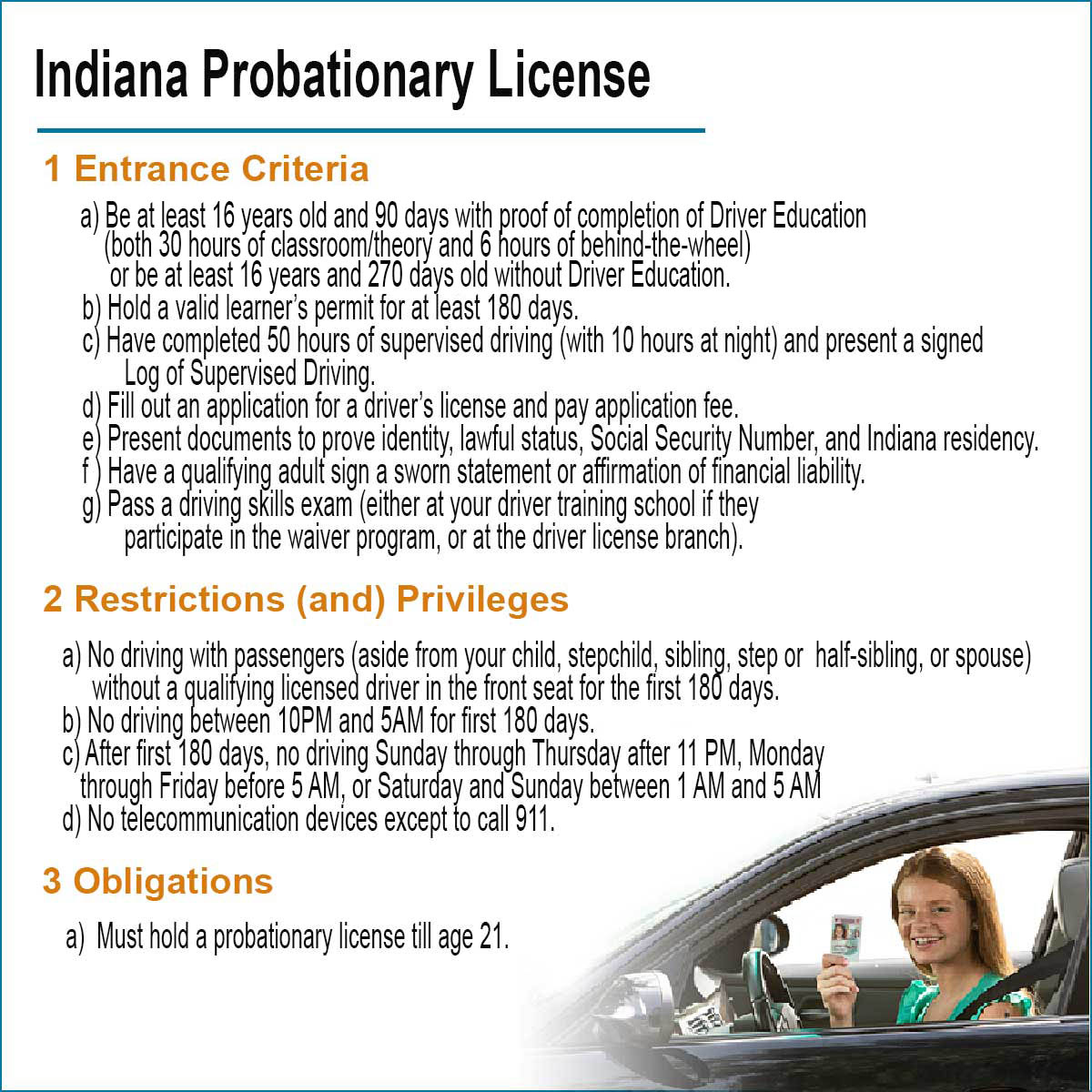What is the Indiana Driver Education Online Course?
Indiana Driver Education is a course that includes two components:
- 30 hours of instruction;
- 6 hours of practice;
There are three incentives for a teen to take driver education:
- A teen between 15 and 16 years old can get their learner's permit early.
- A teen can get their probationary license 1/2 year early.
- A teen can get a waiver for the driving skills test.
30 Hours of Instruction
The 30 hours of instruction is packaged into a course that is regulated by the Indiana Bureau of Motor Vehicles (BMV).
The BMV licenses private schools to offer the course. Teens sign up with a private school and complete the coursework
either online or in a classroom. Safe2Drive is an approved provider of the 30-hour course.
6 Hours of Practice
The 6 hours of practice involves behind-the-wheel driver training with a certified driver instructor. The BMV licenses
schools and instructors to offer driver training. Teens sign up with a school.
Take our Indiana Driver Education course if you want to do any of the following:
- Get on your way to obtaining a learner's permit (you must be at least age 15).
- Obtain a probationary driver's license at the age of 16 years and 90 days (you will also need to complete 6 hours of behind-the-wheel training with a professional driving school).
- Prepare for your knowledge exam.
- Increase or refresh your knowledge of driving skills and laws.
Students seeking Indiana driving privileges must be enrolled at a driver training school licensed by the Indiana Bureau of Motor Vehicles* and must be at least 15 years of age to earn credit for completing online driver training.
*Safe2Drive is an Indiana BMV-licensed driver training school for online Driver Education and satisfies this requirement.
Read the Bill of Rights and the Code of Responsibilities for Driver Education Students.
How Safe2Drive's Online Indiana Driver Education Course Works
Driver education in Indiana consists of two components:
- 30 hours of classroom instruction (this course satisfies this requirement)
- 6 hours of driving instruction with a professional driving school (you will need to sign up with an approved school that offers behind-the-wheel training to meet this requirement)
Here's how our course works:
1. Register and pay. Sign up for our course if you are at least 15 years old. Registration is easy--we'll collect some contact information and give you information on course policies and procedures.
2. Complete the online coursework. Enjoy short lessons full of games, animations, videos and other interactive media elements. The course, per Indiana's requirements, is 30 hours in length. Each lesson is timed to ensure you spend the minimum required time in the course.
Each lesson is followed by a 5-question, multiple-choice quiz. You must score at least 80% to pass the lesson quiz and
move on to the next lesson. Most people pass the lesson quiz on the first attempt, but we provide unlimited retries at no additional cost. Review the lesson material and retake the quiz until you pass!
3. Pass the final exam. At the end of the course, you must pass a 20-question, multiple-choice final exam. A passing score is 80%, which means you must answer at least 16 questions correctly.
Most people pass the exam on the first try. However, there is no need to worry because we give you unlimited retries on the exam as well --- also at no additional cost.
4. Receive your Certificate of Completion. We will email you a Certificate of Completion immediately for free once you pass the final exam.
Take this Certificate of Completion with you when you go to apply for your driver's license when you are at least age 16 and 90 days.
Please Note: You must also complete 6 hours of behind-the-wheel training at a licensed driver training school to complete your Driver Education requirement. The behind-the-wheel and your online coursework can be done concurrently if the behind-the-wheel school allows it. Some behind-the-wheel
providers require you to show them a Certificate of Completion for the online coursework before they allow you to begin your behind-the-wheel training. This is up to the behind-the-wheel school, so please check with the provider you choose and see what their requirements are.
How to Get Your Driver's License (If You're Under Age 18)
Indiana follows a Graduated Driver Licensing program, which means you must go through two stages before you get a fully unrestricted license.
Studies have shown that teen drivers are involved in more collisions than experienced drivers. The Graduated Driver Licensing program allows you to gain experience
gradually with safeguards in place to protect you and other drivers.

Both stages come with a set of qualifications, restrictions, and obligations that guide you through the process of learning to drive safely. For example, a qualification for a learner's permit is that you must be at least 15 years old.
A restriction during the permit stage is that you must drive under the supervision of a qualified adult. An obligation is that you must accumulate a minimum of 50 hours of supervised driving practice.

Stage One: Learner's Permit
The first step towards getting your driver's license is the learner's permit. You may obtain a permit as early as the age of fifteen (15) if you are enrolled in a behind-the-wheel course.
Otherwise, you must wait until you are sixteen (16). You must meet these additional requirements:
- You must fill out an application for a learner's permit and pay the application fee.
- You must present documents to prove identity, lawful status, Social Security Number (unless you are a foreign national, which requires alternative documentation) and Indiana residency (View Acceptable Documents).
- You must have a qualifying adult sign a sworn or affirmed statement of financial responsibility.
The adult who co-signs for financial liability must present a valid form of identification,
including a U.S. government-issued photo identification card that displays a United States address.
The BMV does not accept Matricula Consular cards for purposes of financial liability.
Any form of identity must be a U.S. government-issued identity document.
Below are the qualifying adults who can co-sign the financial liability in order of lawful preference:
- The parent having custody of the minor applicant or a designee of the custodial parent specified by the custodial parent
- The noncustodial parent (as defined in IC 31-9-2-83) of the minor applicant or a designee of the noncustodial parent specified by the noncustodial parent
- The guardian having custody of the minor applicant
- In the absence of a person described in one (1) through three (3), any other adult who is willing to assume the obligations imposed by the provisions of this chapter (IC 9-24-9)
- You must pass a vision test.
- You must pass a knowledge exam.

The primary restriction while holding a permit is that all driving must be supervised. This means you must drive with someone who is qualified to supervise you and is sitting in the front passenger seat.
The person supervising you must be one of the following:
- A licensed driver training instructor or a certified driver rehabilitation specialist, who is both recognized by the BMV and employed through a driver rehabilitation program.
OR
- A licensed driver who has valid (not expired, suspended, or revoked) driving privileges and is 25 years of age or older. The licensed driver must be related to you by blood, marriage, or legal status. You may also choose to practice driving with your spouse, who must be licensed and at least 21 years of age.
While holding a permit, you must accumulate 50 hours of driving practice to qualify for your probationary license. At least 10 hours must be nighttime driving. The permit must be held for 180 days before you can move onto the next stage.
Please Note: Your learner’s permit is valid for two years from the date of issuance (note: if you are a lawful temporary resident, different periods of validity may apply). If you are visiting a license branch to renew your learner’s permit and it has been more than 180 days since your last passed knowledge test, you will need to retest.
Stage Two: Probationary License
The second step is to get a probationary license. The probationary license allows you to drive with fewer restrictions while still providing safeguards to protect you and other drivers.
To get a probationary driver's license, you must do the following:
- You must be least 16 years and 90 days old if you have completed the Driver Education requirement (this includes both the 30 hours of coursework and 6 hours of behind-the-wheel training). If you have not completed the Driver Education requirement, you must wait until you are at least age 16 and 270 days to get your probationary license.
- You must hold a valid learner's permit for at least 180 days.
- You must have completed 50 hours of supervised driving practice (10 hours of which must have been at night), and you must present a signed Log of Supervised Driving. You can download the Log of Supervised Driving from the Indiana BMV's website here.
- You must fill out an application for a driver's license and pay the application fee.
- You must present documents to prove identity, lawful status, Social Security Number (unless you are a foreign national, which requires alternative documentation) and Indiana residency (View Acceptable Documents).
- You must have a qualifying adult sign a sworn or affirmed statement of financial responsibility. The adult who co-signs for financial liability must present a valid form of identification, including a U.S. government-issued photo identification card that displays a United States address. The BMV does not accept Matricula Consular cards for purposes of financial liability. Any form of identity must be a U.S. government-issued identity document. Below are the qualifying adults who can co-sign the financial liability in order of lawful preference:
- The parent having custody of the minor applicant or a designee of the custodial parent specified by the custodial parent
- The noncustodial parent (as defined in IC 31-9-2-83) of the minor applicant or a designee of the noncustodial parent specified by the noncustodial parent
- The guardian having custody of the minor applicant
- In the absence of a person described in one (1) through three (3), any other adult who is willing to assume the obligations imposed by the provisions of this chapter (IC 9-24-9)
- You must pass a driving skills exam (either at your driver training school, if it participates in the waiver program, or at the driver license branch).
You may not drive with any passengers (aside from your child, stepchild, sibling, step or half-sibling, or spouse) for the first 180 days after obtaining your probationary driver’s license unless one of the following individuals is seated in your vehicle’s front passenger seat:
- A licensed individual with valid (not expired, suspended, or revoked) driving privileges who is 25 years of age or older
- Your spouse with valid driving privileges who is 21 years of age or older, or
- A certified Driver Education instructor
For the first 180 days after obtaining your probationary driver’s license, you may not drive between 10 PM and 5 AM. After you have held a probationary driver’s license for 180 days, you may not drive during the following hours:
- Sunday through Thursday, after 11 PM
- Monday through Friday before 5 AM
- Saturday and Sunday, between 1 AM and 5 AM
You may drive during the periods described above if you are participating in, going to, or returning from:
- Lawful employment
- A school-sanctioned activity
- A religious event, or
- If you are accompanied by an individual with valid (not expired, suspended, or revoked) driving privileges who is at least 25 years of age, or your spouse with valid driving privileges who is at least 21 years of age
Indiana law prohibits probationary driver’s license holders from operating a motor vehicle while using any form of telecommunications device, such as a wireless phone, personal digital assistant, pager, or text messaging device unless the device is being used to make a 911 emergency call.
Indiana law requires the BMV to suspend the driving privileges of a juvenile, upon notification from the juvenile’s principal or truancy administrator, for any of the following reasons:
- The juvenile is under an expulsion, exclusion, or second or subsequent suspension from school during one school year
- The juvenile has been determined to be a habitual truant, or
- The juvenile has withdrawn from school

Register Now
What is the Difference Between Driver Education and Driver Training?
Driver education is theory and driver training is practice. Theory and practice. Driver education involves learning the techniques of driving safely by
participating in learning activities such as simulations, videos, animations, and even game-playing. Driver training is "on-the-job" training
where you actually drive a vehicle under the guidance of a driver training instructor. A teen must first complete driver education to obtain a permit
to drive. A permit is required to begin driver training.
Back to Top